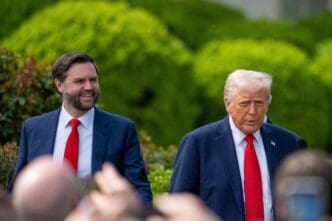Executive Summary
The Story So Far
Why This Matters
Who Thinks What?
Vice President JD Vance visited Israel on Tuesday, October 21, 2025, expressing optimism about the Israel-Hamas ceasefire despite private concerns among some Trump administration officials regarding its potential collapse. His visit comes amidst efforts to ensure Israeli Prime Minister Benjamin Netanyahu’s continued commitment to the U.S.-brokered deal, particularly after recent escalations in the region.
Vance’s Optimism Amidst Fragility
Speaking in Israel, Vance stated, “What we’ve seen the past week gives me great optimism the ceasefire is going to hold.” He acknowledged, however, that he could not say “with 100% certainty that it’s going to work.” The Vice President declined to provide a timeline for the return of all Israeli hostage remains or Hamas’ disarmament, indicating that these processes would “take a little bit of time.”
Vance also cautioned that “if Hamas doesn’t comply with the deal, very bad things are going to happen.” He emphasized that he would not impose an explicit deadline, a stance consistent with President Trump’s approach, due to the inherent difficulties of such negotiations.
Internal Administration Concerns
Despite Vance’s public optimism, sources familiar with the matter told CNN that some Trump administration officials privately harbor concerns about the ceasefire’s fragility. They reportedly worry that the deal could fall apart, and that Prime Minister Netanyahu might work to undermine it.
One U.S. official described Vance’s presence in the region as “Bibisitting,” while another characterized it as a “show of force from the highest-ranking person after the president himself.” The objective, according to officials, is to make the administration’s view clear that the ceasefire must be durable enough to “outlast inevitable skirmishes.” The general belief among U.S. officials is that the truce faces its greatest threat in the short term, necessitating Vance’s swift visit following President Trump’s trip last week.
Recent Escalation and Diplomatic Efforts
Concerns within the administration intensified after Israel accused Hamas of carrying out an attack over the weekend that resulted in the deaths of two IDF soldiers. Israel responded with airstrikes that killed dozens of people in Gaza. U.S. officials reportedly worked to minimize the fallout from these strikes and prevent the ceasefire from being jeopardized.
While both Israel and Hamas accused each other of violating the agreement, both sides ultimately reaffirmed their commitment to the truce. Vance maintained on Tuesday that his trip “had nothing to do with events in the past 48 hours,” asserting that mediating disagreements as they arise would be a “constant effort.”
Longer-Term Peace Plan
Vance was accompanied at his news conference by President Trump’s Middle East envoy, Steve Witkoff, and son-in-law Jared Kushner, who are key architects of the U.S.-negotiated deal. They are in Israel this week to begin working on the longer-term goals of President Trump’s 20-point peace plan for the region.
Witkoff reportedly conveyed to Israel that its response to violence from Hamas must be proportionate to the violation. An Israeli source familiar with the matter indicated that Witkoff also stressed the critical importance of the next 30 days for the deal to hold and for talks to progress to the second phase. Meanwhile, an Israeli official stated that Israel is increasing pressure on the U.S. to ensure Hamas is demilitarized before reconstruction efforts can begin.
President Trump’s Perspective
President Trump has privately and publicly argued that Sunday’s attack on IDF soldiers was not orchestrated by Hamas leaders, but rather was part of a “rebellion.” He suggested that some members of Hamas “got very rambunctious” but believes the group remains committed to the truce and negotiations.
Despite this, Trump did issue a threat to have the group “eradicated” if it becomes ultimately necessary. On social media Tuesday, Trump stated that “great allies” in and around the Middle East would “welcome the opportunity” to enter Gaza and “straighten [out] Hamas” if they continue to “act badly.” He added that he had told these unspecified countries “not yet,” as “there is still hope that Hamas will do what is right.”
Outlook on the Ceasefire
The delicate nature of the Israel-Hamas ceasefire continues to be a central focus of the Trump administration’s diplomatic efforts. Vice President Vance’s visit underscores the administration’s commitment to ensuring the truce’s longevity and advancing the broader objectives of its peace plan for the Middle East, despite ongoing challenges and internal concerns.








